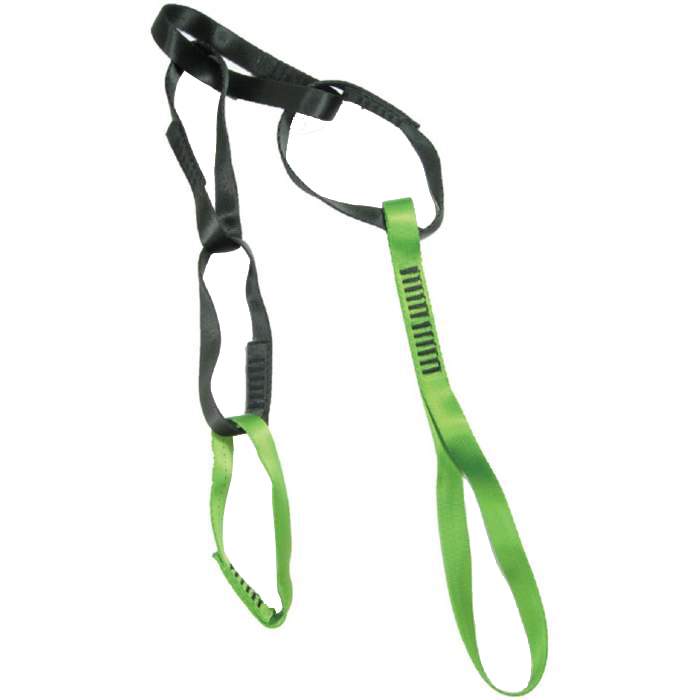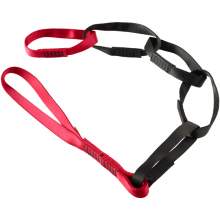Chain Reactor 61.5"
Description
A nylon rigging chain made from 11/16" sewn webbing loops. For rigging applications in climbing and arbor. Made in the USA.
The Chain Reactor is a multi-functional daisy chain designed with full-strength loops most frequently used for personal anchor connections and extending rappel devices. Made from our nylon webbing, each individual loop is full strength and can withstand and absorb impact forces.
In arbor work, the Chain Reactor is ideal as a redirect in SRS work positioning, for choking multiple branches or for knotless rigging.
The Chain Reactor also comes in a Pro Construction, which has a doubled tether connection as well as a long version, which features four additional sling loops.
Retail price
When you click a link below and then checkout online, no matter what you buy (climbing gear or not), we get a small commission that helps us keep this site up-to-date. Thanks!
| Weight (g) | 136 g |
| Type | Chain |
| Material | Nylon / Polyamide |
| Stretch | Dynamic |
Number of Chain Links  Number of LinksHow We CountThis refers to the number of loops (or links) in a chain style personal anchor. Typically, the more links a PAS has, the longer and more versatile it is. More links also means more bulk and weight. Some brands sew the connector end of a PAS to include a dogbone-like loop for holding a carabiner; this is also counted as a loop. WeighMyRack does not count the harness attachment loop here. | 5 |
Extra Features  Features
Adjustable LanyardSome Lanyards have built in buckles or attachment points that allow for adjusting their length. These adjusters do not affect the strength of the lanyard and are useful for finding a comfortable position at a belay or when you need to create space for another climber to pass. Adjustable lanyards should not be confused with adjustable daisies, which are not rated to hold a fall. Bluesign® ProductThis designation signifies that the manufacturer is committed to tracking and reducing the impact of textiles in their gear on the planet. As a third party Bluesign tracks its partners products from material sourcing through manufacturing, packaging, shipping, and distribution. A piece of gear that is considered a Bluesign® product must contain at least 90% Bluesign approved materials and be made by a Bluesign system partner. Built-in CarabinerSome brands include a specific carabiner with their PAS. This is usually because it is designed to orient in a certain way in tighter terminated loop at the end of the device. Some brands make this dogbone-like loop and do no provide a carabiner, this filter designates which brands actually include the carabiner. Full strength girth hitchWhen soft goods like slings are passed around an object and back through themselves, (known as a girth hitch or a lark's foot hitch) their strength is reduced by around half. This form of attachment has long been used to attach climbers to anchors, but has been a point of discussion regarding its safety and potential risks due to materials rubbing on themselves and cutting or wearing through. Some companies have decided to combat this by designing a form of attachment loop that includes an extra loop on the harness end for a girth hitch to pass through which keeps the end from being able to cinch down. Essentially this creates two girth hitches, which doubles the amount of strength in the system (which was cut by half before) making it a 'full strength' way to attach to an anchor. Learn More
The best sustainability certifications | - |
Certification  CertificationUIAA 109 / CE EN 17520Lanyards (or more specifically Belay Lanyards) are a recognized and certified designation by the UIAA and CE for use in mountaineering. This certification UIAA 109 / CE EN 17520 includes testing for reducing shock to the anchor to no more than 10kN and must hold up to 15kN. PAS devices made from Dyneema / UHMWPE aren't usually certifiable as lanyards. UIAA 104/ CE EN 566PAS devices that are made of links are also usually made of UHMWPE / Dyneema and are therefore quite able to pass the certification of a Sling for Mountaineering The strength rating of the UIAA 104/ CE EN 566certification is a whopping 22kN. It should be noted that devices with this certification alone have not been tested to reduce shock or load of any kind and should be considered static material that will transfer 100% of force to an anchor or piece of protection. | unknown |
No reviews yet.
If you know of a good product video that should be here, let us know, and we'll put it up.
If you're looking for gear videos in general, check out our Vimeo and YouTube channels to see the newest gear.






